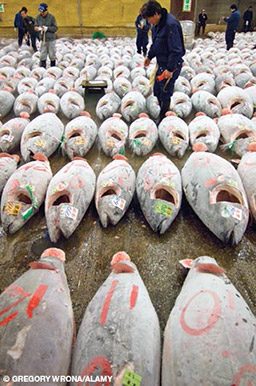Divers are probably more connected to the wonders in the oceans than most people. Those who have been diving the same sites for any length of time have seen the changes firsthand. Overfishing, excessive collecting, pollution, habitat damage and changing environmental conditions all are having an impact on ocean ecosystems.
Overfishing of large predators like sharks for their fins or bluefin tuna for sushi is having devastating consequences on the oceanic food web. Scientists estimate that only 10 percent of predators at the top of the food web remain, and the effects of their absence ripple throughout the system. Yet the hunt continues.
Coral reefs, the favored habitats of many divers worldwide, are reflecting the consequences of ocean warming, and changes in ocean chemistry are affecting their ability to build their skeletons. This inability to regenerate efficiently has a domino effect, as entire communities of reef fishes and marine animals rely on coral reefs for food and shelter.

With wild-caught seafood falling short of the growing global demand, seafood farming is on the rise. Last year, for the first time, more than half of all consumed seafood was raised in farms. Unfortunately, not all farming gives the ocean a break; by farming top carnivores like salmon and tuna, additional pressure is put on our oceans as wild fish are caught to feed farmed fish. On top of that, pollution, disease and other concerns associated with intensive farming in open-water environments are an increasing threat around the world.
It’s not too late to turn the tide. There’s something all of us can do — and it’s easy (especially if you like to eat seafood). By making conscious individual choices when ordering seafood, a huge collective difference can be made.
Education about what is sustainable and what is not is key to knowing what choices to make, and there are several resources available to provide ready access to the information. One of the leaders in the fight for sustainable seafood, the Monterey Bay Aquarium, has been putting the “Best Choices” guide in people’s wallets since 1999. The Seafood Watch pocket guides are tailored to each region of the United States to provide information about locally available choices, and there is a national sushi guide with the English and Japanese names of popular types of sushi.
Recommendations are also available via a free Seafood Watch app for the iPhone and Android. The app is a great resource for travelers, as it automatically pinpoints your current location and serves up seafood choices for the region you’re in. The app includes “Project FishMap,” a feature where users across the country can help identify where they’re finding sustainable seafood choices and tagging those restaurants or markets for others to see. The sharing of information allows others who want to make good choices find these locations when they’re shopping for ocean-friendly seafood.
Asking questions of fishmongers or restaurant wait staff can identify seafood fished or farmed in environmentally responsible ways. By selecting these items, consumers vote with their wallets for best practices and support the building of sustainable markets for ocean-friendly products.
The votes count; big businesses are listening to what customers are saying. A number of major seafood buyers are now working with the Monterey Bay Aquarium to help bring an end to overfishing and other environmentally destructive practices. Your continued demand for seafood from well-managed farms and fisheries will help keep our oceans healthy, giving your children and grandchildren the chance to dive in and enjoy the full bounty and beauty of our oceans.
© Alert Diver — Q3 Summer 2011